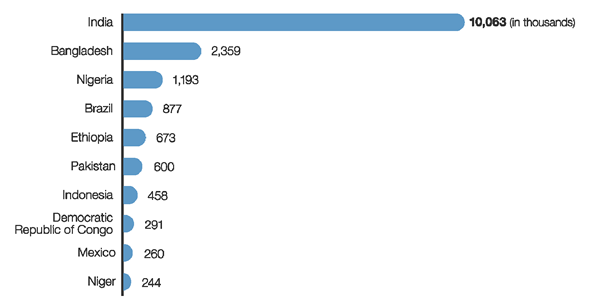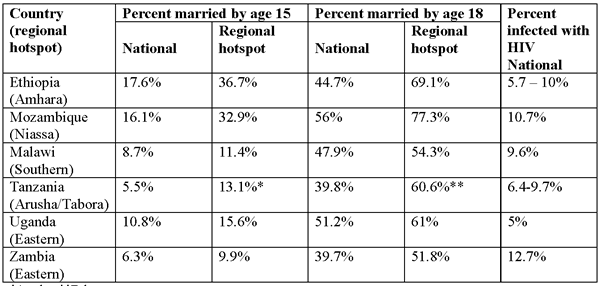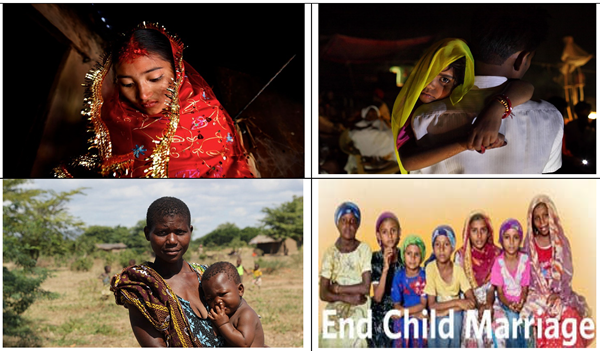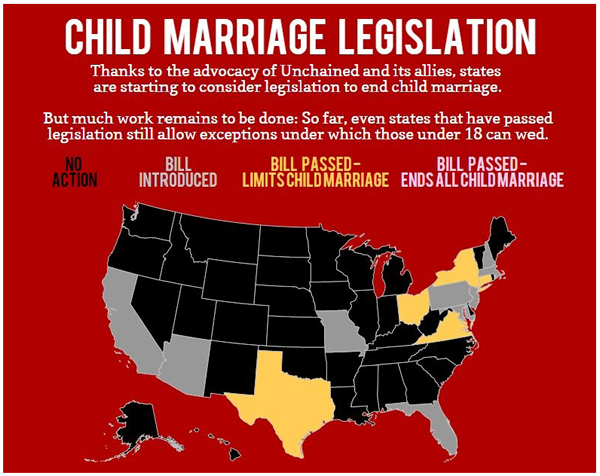Mettre fin au mariage des enfants: un appel à l'action mondialeBulletin WHEC pratique et de directives cliniques de gestion pour les fournisseurs de soins de santé. Subvention à l'éducation fournie par la santé des femmes et de l'Education Center (WHEC). Today, there are nearly 70 million child brides worldwide. Every 2 seconds a young girl is forced into marriage. Be part of the generation that changes that. This review, recommendations and practice bulletin on child marriage are an introduction to various global projects and programs, for ending child marriage, for the healthcare providers. More than 140 million girls below 18 years of age will marry between 2011 and 2020. Furthermore, of the 140 million girls who will marry before they are of 18 years; 50 million will be under the age of 15 years. If current levels of child marriages hold, 14.2 million girls annually or 39,000 will marry too young. With marriage, a girl's childhood abruptly ends. Her health and future prospects immediately fall in jeopardy. The next generation of development programs must make ending child marriage a priority. Moving forward, there must also be more investment in documentation and evaluation of what works to end child marriage - a body of successful programs to expand on. But much more work is required across geographic settings and communities. It is critical that these efforts do not overlook girls who are already married. They are among the marginalized members of society and need special attention in development programs and planning. The purpose of this document is to discuss the issue of child marriage, implications on the communities and societies, accelerating global health agenda and achieving 2030 Sustainable Development Goals (SDGs) by ending child marriage. The silence on the plight of child brides must end. Tackling child marriage is a daunting but possible task, requiring political-will and proactive multi-faceted strategies at the international, national and regional community levels. Traditional notions of child marriage continue to justify it as a positive social norm with social and financial benefits. However, new studies on the health and social consequences reveal far more damaging results. Families, community leaders and the broader community are also essential in helping change norms and expectations about what is possible for girls and women. DefinitionChild marriage, also known as early marriage, is defined as "Any marriage carried out below the age of 18 years, before the girl is physically, physiologically, and psychologically ready to shoulder the responsibilities of marriage and childbearing." Marriage is a formalized, binding partnership between consenting adults, which sanctions sexual relations and gives legitimacy to any offspring. It is still a respected and valued social institution throughout the world and may take different forms in different cultures. In many societies in developing countries, child marriages are used to build or strengthen alliances between families. Sometimes this may even include the betrothals of young children or babies. Child marriage - marriages of under 15-years of age is more common in rural communities. This is because rural communities tend to hold on to more entrenched traditional attitudes and customs. Child marriage remains a widely ignored violation of the health and development rights of girls and young women. Governments are often either unable to enforce existing laws or rectify discrepancies between national laws on marriage age and entrenched customary and religious laws. This is because of the "official tolerance of cultural, societal and customary norms that shape and govern the institution of marriage and family life." In general, there is seldom political-will to act when it comes to women's and girls' human rights. Child marriage is culturally packaged as a social necessity, but in many cases, this amounts to "socially licensed sexual abuse and exploitation of a child." Prevalence and Geography of a ProblemThe practice persists to varying degrees around the globe. The highest prevalence rates, commonly measured by the percentage of women aged twenty to twenty-four who report being married before 18 years, are found in South Asia and West and Central Africa, where an estimated 2 out of 5 girls are married as children. However, in terms of absolute numbers, India surpasses other countries by a wide margin: about 40% of all child marriages take place there. In 41 countries, the prevalence of child marriage is 30% or more (UNFPA). Surveys of child brides conducted by the United Nations (UN) and many non-governmental agencies paint a broad demographic portrait of young married girls:
In some countries, disparities in the prevalence of child marriage also lie along religious, ethnic, or regional lines. For instance, in Guatemala, early marriage is most common among indigenous Mayan communities. Top 10 Countries with Child Brides The Value of a Bride EconomicsPoverty, cultural norms, and the low societal value of women and girls are the primary forces that fuel early marriage, although the relative significance of each varies from community to community. In communities where women are generally not considered viable wage earners, families often view daughters as an economic burden. Impoverished parents may decide to betrothal a daughter early to avoid the cost of education - if schooling is even available, parents have an extra incentive to marry off daughters sooner. Families sometimes marry off a child to erase debts or settle feuds. Dowries and bride prices also factor into timing of child marriages. In such cases, youth is seen as enhancing the value of bride; a younger girl has more time to dedicate to her new family and bear children. In many parts of India, dowries, or money given to the groom's family, can be lowered if the bride is younger. Bride prices, money given to the bride's parents (a custom in many parts of sub-Saharan Africa), rise if a bride marries at an earlier age. Low esteem girls and women facilitates these transactions involving young girls. Health and Human RightsChild Marriage in the context of the HIV EpidemicIn areas of high infection rates, early marriages make girls more vulnerable to HIV. As the HIV epidemic has matured, in many settings it has become a disease of young women. According to UNAIDS, in sub-Saharan Africa, 75% of the 6.2 million young people aged 15-24 years living with HIV are female. At the same time, child marriage, though on the decline, persists. In parts of Africa, large numbers of girls are at risk of child marriage, and many millions of young wives were married as children. To understand these twin phenomena - child marriage and the HIV epidemic - The Population Council adopted a multi-level approach. One level of investigation examines the effect of child marriage on the epidemic, including on rates of HIV infection among women and girls. Where biomarker data are available, it is clear that marriage does not protect girls from HIV infection. And once married, an early end to marriage does not appear to provide much protection. Girls who have become widowed, divorced, or abandoned may be at particularly high risk of HIV and other sexually transmitted diseases, either because of the nature of their marriage or the substantial social exclusion and economic risk they face post-marriage. Moreover, married girls have no realistic options to protect themselves from HIV and other sexually transmitted diseases, since the current protection and management are difficult for women of all ages, and it is almost impossible for married girls to implement. These options include abstinence, partner change or reduction, condom use (which is not possible for married girls seeking pregnancy) and having mutually monogamous sex with an uninfected partner whose HIV status has been discerned. Child Marriage and HIV by country and regional hotspot (Africa)  Child Marriage and Social JusticeA Human Rights Violations Mental Health and Violations Domestic Violence and Suicide Faces of Child Brides  The Road AheadMoving forward, there must also be more investment in documentation and evaluation on what works to end child marriage. A body of successful programs now exists to expand on, but much more work is required across geographic settings and communities. It is critical that these efforts do not overlook girls who are already married. They are among the most marginalized members of society and need special attention in development programs and planning. Married girls, and their peers at risk of early marriage, must be at the center of programs. Families, community leaders and the broader community are also essential in helping change the norms and expectations about what is possible for girls and women. Giving Young Girls and Young Boys A Chance Suggestions for Policy and ProgrammingCountries with high rates of child marriage, high adolescent birth rates, and low levels of satisfied demand for family planning should consider a multi-pronged approach across sectors that encourages delayed marriage for girls. Approaches should include to end child marriage, support married girls and focus on the youngest first-time mothers:
Bringing an end to child marriage, therefore, it is a matter of national priorities and political-will. It requires effective legal frameworks that protects the rights of the children involved, and it requires enforcement of those laws in compliance with human rights standards. It also requires the engagement and support of families and communities who stand up for their daughters and granddaughters. This will win change in otherwise long-standing but harmful social norms and traditions. Most of all, it requires the empowerment of girls themselves; empowerment so that girls are positioned to make decisions at the right time; empowered so that, exercising free and informed consent, girls can make the decisions that will safeguard their own futures, transform their own lives and enable them to live in the dignity to which they, as human beings, are entitled. Recommendations of the Women's Health and Education Center (WHEC)WHEC recommends these strategies for development for ending child marriages:
With international networks WHEC will continue its work to prevent child marriages worldwide. Join our community. End child marriage once and for all. WHEC with its partners will continue to advocate for the elimination of child marriage. In addition, to developing interventions to delay age at marriage, researchers and healthcare providers associated with WHEC will provide social support, targeted health messages, protection strategies, and services appropriate for married girls and their partners in settings where HIV is a concern. Challenges in Enforcing Laws that Prohibit Child MarriageEven where strong legal frameworks exist, and minimum age of 18 years for marriage legislation is on the books, their enforcement is often weak. Here are some common problems and possible solutions:
Countries Response and Tightening Their Laws (2017-review)Several governments called for increased efforts to address child marriage at the High-Level Political Forum (HLPF) on Sustainable Development, and reviewed progress made towards achieving the Sustainable Development Goals (SDGs). 2017 was a difficult year for many around the world. But there are lots of things to feel hopeful about.
But not everything is rosy
Child Marriage Legislation in the United StatesIn the United States, Unchained At Last, Tahirih Justice Centre, Human Rights Watch, and other Civil Society Organizations (CSOs) - have been campaigning to raise the age of marriage to 18 years without exceptions across the country, including a successful campaign in the state of New York to raise the legal age of marriage from 14 years.  Editor's NoteInternational and regional agreements prohibiting child marriage set standards that governments should adhere to in protecting children from being married before they are ready. These standards also act as an accountability measure: governments have to report to the committee that oversee them about how they are implementing the standards. They can be used to hold governments accountable for failure to implement and enforce their obligations related to child marriage under these conventions. Setting the minimum age of marriage at 18 years provides an objective rather than subjective standard of maturity, which safeguards a child from being married when they are not physically, mentally or emotionally ready. Why allow children to marry at an age when for example, they do not have the right to vote or enter into other contracts recognized in law? The most widely accepted definition for a child is 18 years, in line with the Convention on the Rights of the Child. A minimum age of 18 years will also help to ensure that children are able to give their free and full consent to marry and have the minimum level of maturity needed before marrying. Suggested Reading & Policy Briefs
|